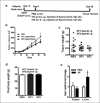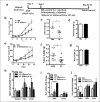Prolonged sulforaphane treatment does not enhance tumorigenesis in oncogenic K-ras and xenograft mouse models of lung cancer
- PMID: 22919281
- PMCID: PMC3424666
- DOI: 10.4103/1477-3163.98459
Prolonged sulforaphane treatment does not enhance tumorigenesis in oncogenic K-ras and xenograft mouse models of lung cancer
Abstract
Background: Sulforaphane (SFN), an activator of nuclear factor erythroid-2 related factor 2 (Nrf2), is a promising chemopreventive agent which is undergoing clinical trial for several diseases. Studies have indicated that there is gain of Nrf2 function in lung cancer and other solid tumors because of mutations in the inhibitor Kelch-like ECH-associated protein 1 (Keap1). More recently, several oncogenes have been shown to activate Nrf2 signaling as the main prosurvival pathway mediating ROS detoxification, senescence evasion, and neoplastic transformation. Thus, it is important to determine if there is any risk of enhanced lung tumorigenesis associated with prolonged administration of SFN using mouse models of cancer.
Materials and methods: We evaluated the effect of prolonged SFN treatment on oncogenic K-ras (K-ras(LSL-G12D))-driven lung tumorigenesis. One week post mutant-K-ras expression, mice were treated with SFN (0.5 mg, 5 d/wk) for 3 months by means of a nebulizer. Fourteen weeks after mutant K-ras expression (K-ras(LSL-G12D)), mice were sacrificed, and lung sections were screened for neoplastic foci. Expression of Nrf2-dependent genes was measured using real time RT-PCR. We also determined the effect of prolonged SFN treatment on the growth of preclinical xenograft models using human A549 (with mutant K-ras and Keap1 allele) and H1975 [with mutant epidermal growth factor receptor (EGFR) allele] nonsmall cell lung cancer cells.
Results: Systemic SFN administration did not promote the growth of K-ras(LSL-G12D)-induced lung tumors and had no significant effect on the growth of A549 and H1975 established tumor xenografts in nude mice. Interestingly, localized delivery of SFN significantly attenuated the growth of A549 tumors in nude mice, suggesting an Nrf2-independent antitumorigenic activity of SFN.
Conclusions: Our results demonstrate that prolonged SFN treatment does not promote lung tumorigenesis in various mouse models of lung cancer.
Keywords: EGFR; K-ras; Keap1; Nrf2; lung cancer; sulforaphane.
Conflict of interest statement
Figures




Similar articles
-
Simultaneous K-ras activation and Keap1 deletion cause atrophy of pancreatic parenchyma.Am J Physiol Gastrointest Liver Physiol. 2018 Jan 1;314(1):G65-G74. doi: 10.1152/ajpgi.00228.2017. Epub 2017 Sep 28. Am J Physiol Gastrointest Liver Physiol. 2018. PMID: 28971839
-
Sulforaphane suppresses in vitro and in vivo lung tumorigenesis through downregulation of HDAC activity.Biomed Pharmacother. 2016 Mar;78:74-80. doi: 10.1016/j.biopha.2015.11.007. Epub 2016 Jan 14. Biomed Pharmacother. 2016. PMID: 26898427
-
The discovery and characterization of K-563, a novel inhibitor of the Keap1/Nrf2 pathway produced by Streptomyces sp.Cancer Med. 2019 Mar;8(3):1157-1168. doi: 10.1002/cam4.1949. Epub 2019 Feb 8. Cancer Med. 2019. PMID: 30735010 Free PMC article.
-
Kelch-like ECH-associated Protein 1/Nuclear Factor Erythroid 2-related Factor 2 Pathway and Its Interplay with Oncogenes in Lung Tumorigenesis.J Cancer Prev. 2024 Dec 30;29(4):89-98. doi: 10.15430/JCP.24.021. J Cancer Prev. 2024. PMID: 39790220 Free PMC article. Review.
-
Modulation of mitochondrial functions by the indirect antioxidant sulforaphane: a seemingly contradictory dual role and an integrative hypothesis.Free Radic Biol Med. 2013 Dec;65:1078-1089. doi: 10.1016/j.freeradbiomed.2013.08.182. Epub 2013 Aug 30. Free Radic Biol Med. 2013. PMID: 23999506 Review.
Cited by
-
KEAP1 and Done? Targeting the NRF2 Pathway with Sulforaphane.Trends Food Sci Technol. 2017 Nov;69(Pt B):257-269. doi: 10.1016/j.tifs.2017.02.002. Epub 2017 Feb 16. Trends Food Sci Technol. 2017. PMID: 29242678 Free PMC article.
-
Broccoli or Sulforaphane: Is It the Source or Dose That Matters?Molecules. 2019 Oct 6;24(19):3593. doi: 10.3390/molecules24193593. Molecules. 2019. PMID: 31590459 Free PMC article. Review.
-
NFkB and Nrf2 in esophageal epithelial barrier function.Tissue Barriers. 2013 Dec 1;1(5):e27463. doi: 10.4161/tisb.27463. Epub 2013 Dec 10. Tissue Barriers. 2013. PMID: 24790804 Free PMC article.
-
Sulforaphane Impact on Reactive Oxygen Species (ROS) in Bladder Carcinoma.Int J Mol Sci. 2021 May 31;22(11):5938. doi: 10.3390/ijms22115938. Int J Mol Sci. 2021. PMID: 34073079 Free PMC article. Review.
-
Sulforaphane potentiates anticancer effects of doxorubicin and attenuates its cardiotoxicity in a breast cancer model.PLoS One. 2018 Mar 8;13(3):e0193918. doi: 10.1371/journal.pone.0193918. eCollection 2018. PLoS One. 2018. PMID: 29518137 Free PMC article.
References
-
- London SJ, Yuan JM, Chung FL, Gao YT, Coetzee GA, Ross RK, et al. Isothiocyanates, glutathione S-transferase M1 and T1 polymorphisms, and lung-cancer risk: a prospective study of men in Shanghai, China. Lancet. 2000;356:724–9. - PubMed
-
- Ambrosone CB, McCann SE, Freudenheim JL, Marshall JR, Zhang Y, Shields PG. Breast cancer risk in premenopausal women is inversely associated with consumption of broccoli, a source of isothiocyanates, but is not modified by GST genotype. J Nutr. 2004;134:1134–8. - PubMed
-
- Michaud DS, Spiegelman D, Clinton SK, Rimm EB, Willett WC, Giovannucci EL. Fruit and vegetable intake and incidence of bladder cancer in a male prospective cohort. J Natl Cancer Inst. 1999;91:605–13. - PubMed
-
- Tang L, Zirpoli GR, Guru K, Moysich KB, Zhang Y, Ambrosone CB, et al. Consumption of raw cruciferous vegetables is inversely associated with bladder cancer risk. Cancer Epidemiol Biomarkers Prev. 2008;17:938–44. - PubMed
Grants and funding
LinkOut - more resources
Full Text Sources
Molecular Biology Databases
Research Materials
Miscellaneous

